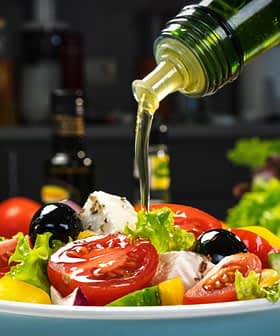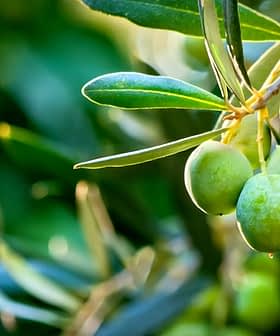
What an interesting couple of weeks it’s been. On July 14th we received a late-night tip that the UC Davis Olive Center was going to release a report that would conclude most of the “extra virgin” olive oils we buy don’t deserve to be called that. We broke the story, posting the report hours before anyone else, and we’ve been bringing you developments ever since. Allegations of fraud, profiteering and public relations wars weren’t what we had in mind when we switched our server on a few months ago with the tag line “olive oil news, reviews and discussion,” but news happens and olive oil is our beat.
We’re not too surprised that most olive oils from California supermarket shelves failed to meet extra virgin guidelines. Let’s say you’re the head of a billion-euro olive oil conglomerate who has to answer to stockholders while producing ever-improving yearly results. You produce a certain amount of high-quality extra virgin olive oil for your bread-and-butter domestic customers, but imagine the pressure to leverage that production and your century-old brand name by watering the good stuff down with cheaper additives and selling it, ships full of it, to unsuspecting populaces who don’t know the difference, and whose governments won’t enforce the weak laws in place. The United States is a cash-cow to unscrupulous olive oil producing giants who have long worried more about brand-building and distribution networks than the quality of their olive oils.
So what’s changing now? Emboldened by the recent revisions by the US Department of Agriculture which, at least, requires minimum standards for extra virgin labeling, the California Olive Oil Council and their friends at the Davis Olive Center are pointing out again that consumers in the States are getting ripped off. The small sampling reflected a study done on the cheap, but the inescapable reality remains, and we’d bet you could duplicate the tests in any number of cash cow countries around the world and get similar results. Try it in China, India, Japan, Mexico, Canada, Germany.
Today a lawsuit was announced in typical American fashion, complete with a semi-celebrity chef plaintiff and “prominent restaurateurs,” to put the squeeze on the big companies that fill the olive oil shelves of places like Costco, Walmart and Albertson’s. Rachael Ray’s brand is among the named counterfeits, although America’s culinary sweetheart is more likely a hapless victim like the rest of us. Maybe this is what it needed to come to. Nothing happens here without the buzz.
This isn’t what we want to write about in these pages (but we will). We’d rather talk about the people who make olive oil, how to use and enjoy it, its ancient culture and its place in our modern ways of life. And while we’d like to thank the University of California, the International Olive Council, North American Olive Oil Association, and the law firm of Callahan and Blaine for the tremendous growth in our readership, we’re also getting a ton of emails from readers who are confused and want some guidance. They’d like to know how to buy extra virgin olive oil without getting taken.
Frankly, we don’t have that problem. The editorial office of Olive Oil Times receives more than its fair share of really great extra virgin olive oil from producers who must think if they send us free stuff we’ll write about them (and we just might). We’ll never have to buy another bottle again and if we could share this ridiculous stash with our readers, you know we would. But let me pretend for a minute that I had to actually go out and buy a bottle of good olive oil from, say, a grocery store. Our Denise Johnson posted a piece recently about the slim pickings at a typical New England supermarket. She had a choice between some of the brands implicated in “The Study” and “premium” extra virgin stuff from identified origins that might have been pretty good, had it not been pre-Obama.
There’s a buzzword going around in the high-end extra virgin olive oil producing world: traceability. It’s possible now to take the lot number from some high-end bottles of EVOO, enter it on a website, and see comprehensive information about the oil including the harvest date, varietals, and an aerial view of the parcel the olives were picked from. In order to really know what you’re buying, there needs to be a degree of traceability. With a lot of food products, including some that might even bear famous names like Rachael Ray, or Paul Newman, it might not matter as much. With extra virgin olive oil, it does. Premium orange juice is $3 a quart. Premium olive juice can be ten times that. We need to know what year the olives were picked, and when the oil was bottled.
Alex “A‑Rod” Rodriguez, one of the most gifted baseball players of all time, hit his 600th home run this week amid great fanfare and adoration. Few seemed to mind that he admitted to using steroids during a time that has been coined the “Steroids Era.” Professional baseball is now in what’s called the “Era of Testing” during which, it’s widely believed, no one can get away with taking performance-enhancing drugs under such intense scrutiny.
I believe we’re entering a similar period in the olive oil business. Dan Flynn’s study and Dan Callahan’s lawsuit will mark the beginning of the “Era of Testing” for extra virgin olive oil and it won’t be long before we can be quite sure what we buy in the supermarket is what it claims to be. Just like I knew A‑Rod’s homer resulted from his own natural talent (and a fastball high in the zone).
The olive oil producers and marketers implicated in the process will make it through, just like Alex Rodriguez, as long as they don’t blow it again. Consumers will soon be looking to labels for the free fatty acid (FFA) and peroxide values, harvest dates and countries of origin. You’ll scan a bar code with your phone to see a Google map of the grove. Traceability.
In the meantime, ask your grocer why there’s no date on the olive oil. Choose a supermarket brand to use for cooking and consider paying more for a premium extra virgin made by an artisan producer, from the country of your choice, to use for everything else. If you enjoy extra virgin olive oil enough to read this post, you owe it to yourself to learn how to distinguish the good from the bad, the great from the not so great. You can take a course, pick up a book, read some of our posts on the subject, or simply practice comparing different brands at home. You won’t be sorry.








